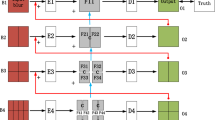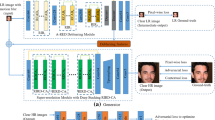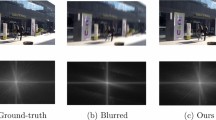Abstract
Image deblurring is a widely researched topic in low-level vision. Over the last few years, many researchers try to deblur by stacking multi-scale pyramid structures, which inevitably increases the computational complexity. In addition, most of the existing deblurring methods do not adequately model long-range contextual information, making the structure of blurred objects not well restored. To address the above issues, we propose a novel context-aware multi-scale convolutional neural network (CDMC-Net) for image deblurring. We progressively restore latent sharp images in two stages, and a cross-stage feature aggregation (CSFA) strategy is introduced to enhance the information flow interaction between the two stages. The key design of CDMC-Net to reduce the complexity is the use of a multi-input multi-output encoder-decoder at each stage, which can process multi-scale blurry images in a coarse-to-fine manner. Furthermore, to effectively capture long-range context information in different scenarios, we propose a multi-strip feature extraction module (MSFM). Its strip pooling with different kernel sizes allows the network to aggregate rich global and local contextual information. Extensive experimental results demonstrate that CDMC-Net outperforms state-of-the-art motion deblurring methods on both synthetic benchmark datasets and real blurred images. We also use CDMC-Net as a pre-processing step for object detection to further verify the effectiveness of our proposed deblurring method in downstream vision tasks.













Similar content being viewed by others
Explore related subjects
Discover the latest articles and news from researchers in related subjects, suggested using machine learning.Availability of data or code
Code and data are available.
References
Mao L, Li X, Yang D, Zhang R (2021) Convolutional feature frequency adaptive fusion object detection network. Neural Process Lett 53(5):3545–3560
Leng J, Liu Y, Wang Z, Hu H, Gao X (2022) Crossnet: detecting objects as crosses. IEEE Trans Multimedia 24:861–875
Ke R, Aviles-Rivero AI, Pandey S, Reddy S, Schönlieb C-B (2022) A three-stage self-training framework for semi-supervised semantic segmentation. IEEE Trans Image Process 31:1805–1815
Li Y, Li M, Li Z, Xiao C, Li H (2022) Efrnet: Efficient feature reuse network for real-time semantic segmentation. Neural Processing Letters 1–13. https://doi.org/10.1007/s11063-022-10740-w
Vaquero L, Brea VM, Mucientes M (2022) Tracking more than 100 arbitrary objects at 25 fps through deep learning. Pattern Recogn 121:108205
Xiang X, Ren W, Qiu Y, Zhang K, Lv N (2021) Multi-object tracking method based on efficient channel attention and switchable atrous convolution. Neural Process Lett 53(4):2747–2763
Tang S, Xie X, Xia M, Luo L, Liu P, Li Z (2018) Spatial-scale-regularized blur kernel estimation for blind image deblurring. Signal Processing: Image Communication 68:138–154
Chen L, Fang F, Wang T, Zhang G (2019) Blind image deblurring with local maximum gradient prior. In: Proceedings of the IEEE/CVF Conference on Computer Vision and Pattern Recognition, pp. 1742–1750
Krishnan D, Tay T, Fergus R (2011) Blind deconvolution using a normalized sparsity measure. In: Proceedings of the IEEE Conference on Computer Vision and Pattern Recognition, pp. 233–240. IEEE
Bai Y, Cheung G, Liu X, Gao W (2018) Graph-based blind image deblurring from a single photograph. IEEE Trans Image Process 28(3):1404–1418
Xu L, Zheng S, Jia J (2013) Unnatural l0 sparse representation for natural image deblurring. In: Proceedings of the IEEE Conference on Computer Vision and Pattern Recognition, pp. 1107–1114
Pan J, Sun D, Pfister H, Yang M-H (2016) Blind image deblurring using dark channel prior. In: Proceedings of the IEEE Conference on Computer Vision and Pattern Recognition, pp. 1628–1636
Bochkovskiy A, Wang C-Y, Liao H-YM (2020) Yolov4: Optimal speed and accuracy of object detection. arXiv preprint arXiv:2004.10934
Liu J, Shao H, Jiang Y, Deng X (2022) Cnn-based hidden-layer topological structure design and optimization methods for image classification. Neural Processing Letters 1–12. https://doi.org/10.1007/s11063-022-10742-8
Sun J, Cao W, Xu Z, Ponce J (2015) Learning a convolutional neural network for non-uniform motion blur removal. In: Proceedings of the IEEE Conference on Computer Vision and Pattern Recognition, pp. 769–777
Schuler CJ, Hirsch M, Harmeling S, Schölkopf B (2015) Learning to deblur. IEEE Trans Pattern Anal Mach Intell 38(7):1439–1451
Xu X, Pan J, Zhang Y-J, Yang M-H (2017) Motion blur kernel estimation via deep learning. IEEE Trans Image Process 27(1):194–205
Nah S, Hyun Kim T, Mu Lee K (2017) Deep multi-scale convolutional neural network for dynamic scene deblurring. In: Proceedings of the IEEE Conference on Computer Vision and Pattern Recognition, pp. 3883–3891
Purohit K, Rajagopalan A (2020) Region-adaptive dense network for efficient motion deblurring. Proceedings of the AAAI Conference on Artificial Intelligence 34:11882–11889
Zhang K, Luo W, Zhong Y, Ma L, Stenger B, Liu W, Li H (2020) Deblurring by realistic blurring. In: Proceedings of the IEEE/CVF Conference on Computer Vision and Pattern Recognition, pp. 2737–2746
Chen C, Chen Q, Xu J, Koltun V (2018) Learning to see in the dark. In: Proceedings of the IEEE Conference on Computer Vision and Pattern Recognition, pp. 3291–3300
Cai J, Zuo W, Zhang L (2020) Dark and bright channel prior embedded network for dynamic scene deblurring. IEEE Trans Image Process 29:6885–6897
Tang K, Xu D, Liu H, Zeng Z (2021) Context module based multi-patch hierarchical network for motion deblurring. Neural Process Lett 53(1):211–226
Shen Z, Wang W, Lu X, Shen J, Ling H, Xu T, Shao L (2019) Human-aware motion deblurring. In: Proceedings of the IEEE/CVF International Conference on Computer Vision, pp. 5572–5581
Suin M, Purohit K, Rajagopalan A (2020) Spatially-attentive patch-hierarchical network for adaptive motion deblurring. In: Proceedings of the IEEE/CVF Conference on Computer Vision and Pattern Recognition, pp. 3606–3615
Zhang Y, Li K, Li K, Zhong B, Fu Y (2019) Residual non-local attention networks for image restoration. arXiv preprint arXiv:1903.10082
Kupyn O, Budzan V, Mykhailych M, Mishkin D, Matas J (2018) Deblurgan: Blind motion deblurring using conditional adversarial networks. In: Proceedings of the IEEE Conference on Computer Vision and Pattern Recognition, pp. 8183–8192
Kupyn O, Martyniuk T, Wu J, Wang Z (2019) Deblurgan-v2: Deblurring (orders-of-magnitude) faster and better. In: Proceedings of the IEEE/CVF International Conference on Computer Vision, pp. 8878–8887
Tao X, Gao H, Shen X, Wang J, Jia J (2018) Scale-recurrent network for deep image deblurring. In: Proceedings of the IEEE Conference on Computer Vision and Pattern Recognition, pp. 8174–8182
Gao H, Tao X, Shen X, Jia J (2019) Dynamic scene deblurring with parameter selective sharing and nested skip connections. In: Proceedings of the IEEE/CVF Conference on Computer Vision and Pattern Recognition, pp. 3848–3856
Wan S, Tang S, Xie X, Gu J, Huang R, Ma B, Luo L (2021) Deep convolutional-neural-network-based channel attention for single image dynamic scene blind deblurring. IEEE Trans Circuits Syst Video Technol 31(8):2994–3009
Wu Y, Hong C, Zhang X, He Y (2021) Stack-based scale-recurrent network for face image deblurring. Neural Process Lett 53(6):4419–4436
Pan J, Bai H, Tang J.: Cascaded deep video deblurring using temporal sharpness prior. In: Proceedings of the IEEE/CVF Conference on Computer Vision and Pattern Recognition, pp. 3043–3051 (2020)
Zamir SW, Arora A, Khan S, Hayat M, Khan FS, Yang M-H, Shao L (2021) Multi-stage progressive image restoration. In: Proceedings of the IEEE/CVF Conference on Computer Vision and Pattern Recognition, pp. 14821–14831
Chen L, Lu X, Zhang J, Chu X, Chen C (2021) Hinet: Half instance normalization network for image restoration. In: Proceedings of the IEEE/CVF Conference on Computer Vision and Pattern Recognition, pp. 182–192
Zhang D, Shao J, Liang Z, Gao L, Shen HT (2021) Large factor image super-resolution with cascaded convolutional neural networks. IEEE Trans Multimedia 23:2172–2184
Hou Q, Zhang L, Cheng M-M, Feng J (2020) Strip pooling: Rethinking spatial pooling for scene parsing. In: Proceedings of the IEEE/CVF Conference on Computer Vision and Pattern Recognition, pp. 4003–4012
Shan Q, Jia J, Agarwala A (2008) High-quality motion deblurring from a single image. Acm transactions on graphics (tog) 27(3):1–10
Whyte O, Sivic J, Zisserman A, Ponce J (2012) Non-uniform deblurring for shaken images. Int J Comput Vision 98(2):168–186
Bai Y, Jia H, Jiang M, Liu X, Xie X, Gao W (2020) Single-image blind deblurring using multi-scale latent structure prior. IEEE Trans Circuits Syst Video Technol 30(7):2033–2045
Yan R, Shao L (2016) Blind image blur estimation via deep learning. IEEE Trans Image Process 25(4):1910–1921
Gong D, Yang J, Liu L, Zhang Y, Reid I, Shen C, Van Den Hengel A, Shi Q (2017) From motion blur to motion flow: A deep learning solution for removing heterogeneous motion blur. In: Proceedings of the IEEE Conference on Computer Vision and Pattern Recognition, pp. 2319–2328
Lin T-Y, Dollár P, Girshick R, He K, Hariharan B, Belongie S (2017) Feature pyramid networks for object detection. In: Proceedings of the IEEE Conference on Computer Vision and Pattern Recognition, pp. 2117–2125
Zhang H, Dai Y, Li H, Koniusz P (2019) Deep stacked hierarchical multi-patch network for image deblurring. In: Proceedings of the IEEE/CVF Conference on Computer Vision and Pattern Recognition, pp. 5978–5986
Park D, Kang DU, Kim J, Chun SY (2020) Multi-temporal recurrent neural networks for progressive non-uniform single image deblurring with incremental temporal training. In: European Conference on Computer Vision, pp. 327–343. Springer
Cho S-J, Ji S-W, Hong J-P, Jung S-W, Ko S-J (2021) Rethinking coarse-to-fine approach in single image deblurring. In: Proceedings of the IEEE/CVF International Conference on Computer Vision, pp. 4641–4650
Tsai F-J, Peng Y-T, Lin Y-Y, Tsai C-C, Lin C-W (2021) Banet: Blur-aware attention networks for dynamic scene deblurring. arXiv e-prints, 2101 arXiv:2101.07518
Guo C, Li C, Guo J, Cong R, Fu H, Han P (2018) Hierarchical features driven residual learning for depth map super-resolution. IEEE Trans Image Process 28(5):2545–2557
Pang Y, Wang T, Anwer RM, Khan FS, Shao L (2019) Efficient featurized image pyramid network for single shot detector. In: Proceedings of the IEEE/CVF Conference on Computer Vision and Pattern Recognition, pp. 7336–7344
Jiang K, Wang Z, Yi P, Chen C, Wang G, Han Z, Jiang J, Xiong Z (2021) Multi-scale hybrid fusion network for single image deraining. IEEE Transactions on Neural Networks and Learning Systems. https://doi.org/10.1109/TNNLS.2021.3112235
Rim J, Lee H, Won J, Cho S (2020) Real-world blur dataset for learning and benchmarking deblurring algorithms. In: European Conference on Computer Vision, pp. 184–201. Springer
Huynh-Thu Q, Ghanbari M (2008) Scope of validity of psnr in image/video quality assessment. Electron Lett 44(13):800–801
Wang Z, Bovik AC, Sheikh HR, Simoncelli EP (2004) Image quality assessment: from error visibility to structural similarity. IEEE Trans Image Process 13(4):600–612
Funding
This work was supported by the National Natural Science Foundation of China under Grants 62066047, 61966037.
Author information
Authors and Affiliations
Contributions
Zhao Qian and Yang Hao conceived the experiments, and Zhao Qian performed the experiments. All authors reviewed the manuscript.
Corresponding author
Ethics declarations
Conflicts of interest
The authors declared that they have no conflicts of interest to this work.
Ethical approval
The experiments in this article are all realized through program operation, which will not cause harm to humans and animals, and will not cause moral and ethical problems.
Consent to participate:
Welcome readers to communicate.
Consent for publication:
Completed at Yunnan University on March 22, 2022
Additional information
Publisher's Note
Springer Nature remains neutral with regard to jurisdictional claims in published maps and institutional affiliations.
Rights and permissions
Springer Nature or its licensor holds exclusive rights to this article under a publishing agreement with the author(s) or other rightsholder(s); author self-archiving of the accepted manuscript version of this article is solely governed by the terms of such publishing agreement and applicable law.
About this article
Cite this article
Zhao, Q., Zhou, D. & Yang, H. CDMC-Net: Context-Aware Image Deblurring Using a Multi-scale Cascaded Network. Neural Process Lett 55, 3985–4006 (2023). https://doi.org/10.1007/s11063-022-10976-6
Accepted:
Published:
Issue Date:
DOI: https://doi.org/10.1007/s11063-022-10976-6




